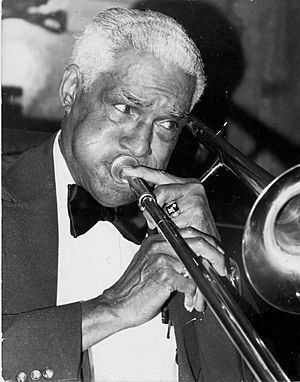Louis Nelson facts for kids
Louis Hall Nelson (September 17, 1902 – April 5, 1990) was a famous New Orleans jazz trombonist. He was known for his smooth playing style and his long career in jazz music.
Contents
Early Life and Musical Beginnings
Louis Nelson was born in New Orleans, Louisiana, on September 17, 1902. His father, Dr. George Harry Nelson, was a medical doctor. His mother, Anna Hattie Adams Nelson, was a teacher and pianist. She had studied at the Boston Conservatory of Music.
Louis had two siblings, Mary and George Jr. His parents and sister played the piano, and his brother played the saxophone. Music was a big part of their family life. In 1902, his family moved to Napoleonville, Louisiana.
Learning the Trombone
When Louis was fifteen, he started playing the valve trombone. He soon switched to the slide trombone. He learned from Professor Claiborne Williams in Donaldsonville, Louisiana. Professor Williams taught him how to breathe properly for playing. He also taught Louis that feeling and understanding music were more important than just playing notes perfectly.
Louis once said, "I heard a fellow, Lawrence Johnson, playing with a band out of Napoleonville. I said, one day I'm going to play trombone like that man." He admired Johnson's smooth sound.
Education in New Orleans
During the week, Louis lived with Reverend Isaac H. Hall in New Orleans. Reverend Hall was a family friend. Louis attended the Lutheran School and New Orleans University (high school). He graduated in 1919.
Starting His Music Career
Louis Nelson's first band was Joe Gabriel's band from Thibodaux, Louisiana. He traveled with them through Cajun country. They played in dance halls, earning a dollar a night.
Marriage and Early Jazz Bands
In 1922, Louis married Julia Kissack. They briefly moved to New York City. However, they soon returned to New Orleans because Julia became ill.
In the 1920s, Louis played jazz with many famous musicians in New Orleans. These included Kid Rena, Punch Miller, Sam Morgan (musician), and Papa Celestin.
Louis and Julia had two children: Louis Hall Nelson Jr. and Anna Nelson Tircuit. Sadly, Julia passed away in 1928.
Playing with Sidney Desvigne
After his wife's death, Louis joined the Sidney Desvigne Orchestra. This band played for different audiences. They performed at places like the New Orleans Country Club. They also played for black audiences at venues like the Pythian Temple.
For fifteen years, Louis played with Desvigne's Orchestra. They even played on summer Mississippi River cruises. They traveled as far north as Minneapolis.
Overcoming Challenges
During the Great Depression, finding work was tough. Louis joined the Works Progress Administration (WPA). He became the lead trombonist in the WPA band. When they weren't playing music, the musicians helped with public works, like digging stumps in City Park.
When World War II began, Louis Nelson joined the U.S. Navy. He became a Musician 1st Class. He was stationed at the U.S. Navy base in Memphis, Tennessee. After the war, he returned to New Orleans. He continued playing with Sidney Desvigne's Orchestra until the band moved to California.
Day Jobs and New Bands
In 1945, Nelson joined the Kid Thomas Valentine band. They played one night a week at dance halls. He also worked with the Herbert Leary Orchestra.
To support himself, Louis had to take other jobs. He worked as a driver for the post office and a fish merchant. He also worked as a chauffeur and a janitor.
Recording and Preservation Hall
In 1949, Louis Nelson made his first recording. He recorded with clarinetist Big Eye Louis Nelson Delisle and other musicians. This recording was made by jazz historian Bill Russell. It marked the start of Louis Nelson's long recording career.
Preservation Hall
In the 1950s, a man named Larry Borenstein owned an art gallery in the French Quarter. He loved jazz music. He started inviting the Kid Thomas Valentine band to play "rehearsals" at his gallery. This allowed people to hear jazz in the evenings.
In 1961, Preservation Hall officially opened. It became a famous place for traditional New Orleans jazz. Allan Jaffe later took over the hall. Louis Nelson found steady work there. He also played at other venues on Bourbon Street.
Preservation Hall gave Nelson many chances to travel. He toured as a soloist and with bands like Billie and De De Piece and Kid Thomas Valentine's bands.
Touring the World
From 1963 until his death in 1990, Louis Nelson toured extensively. He traveled with the George Lewis (clarinetist) band to Japan, Europe, South America, Australia, Canada, and Mexico. He also performed all over the United States.
Louis Nelson played at every New Orleans Jazz & Heritage Festival until he passed away. In 1981, he received a grant to create a program. He played for New Orleans public school students and taught them about jazz history.
Legacy
Louis Hall Nelson passed away on April 5, 1990, due to injuries from a car accident. He was widely recorded throughout his career. He recorded music for the movie Pretty Baby (1978 film) (1978). He also appeared in many jazz documentaries. These included Art Ford's House Party and Live the Jazz.
Louis Nelson's contributions helped keep traditional New Orleans jazz alive.


